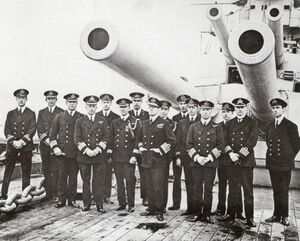Battle Cruiser Force

The Battle Cruiser Force, known as the Battle Cruiser Fleet from 1915 to 1916, was the name given to part of the reconnaissance forces of the Grand Fleet.
Inception
The formation of a Battle Cruiser Fleet was mooted on 4 February, 1915, when the First Lord of the Admiralty, Winston S. Churchill, wrote to the Commander-in-Chief of the Grand Fleet, Sir John R. Jellicoe:
My proposal was to make Lion Fleet Flagship, making Brock Commodore 1st Class in command of the three other cats thus not shifting from Princess Royal. Owing to absence of Inflexible and Indefatigable and repairs to Indomitable, formation of a 3rd Squadron cannot be achieved till about March 1st. Meanwhile Patey and Brock under Beatty can divide the Battle Cruisers available. De Robeck is required temporarily for an operation of importance in the Mediterranean about which I am writing to you. As soon as he is free the three Squadrons can be formed and he can have one of them. Patey quite understands he is to serve under Beatty.
Your suggested disposition of the Light Cruiser Squadron to the B.C. Squadron will be adopted.[1]
The Head of M. Branch, Alexander Flint, signed a confidential memorandum on 8 February which announced:
The attached organisation of the Battle Cruiser Fleet, with attached Light Cruiser Squadrons, has been approved, and the appointments of the Flag Officers and Commodores shown thereon have been made.
Vice Admiral Patey will for the present also have under his orders the "Indomitable" and the 3rd Light Cruiser Squadron.[2]
In the same paper was the following announcement:
Their Lordships have selected Vice Admiral Sir G.E.Patey,K.C.V.O., to be Vice Admiral Commanding, 2nd Battle Cruiser Squadron, under the orders of the Vice Admiral Commanding,Battle Cruiser Fleet, flying his flag in H.M.S. [sic] "Australia".[3]
The organisation of the Battle Cruiser Fleet was promulgated to senior officers of the Navy in Home Waters on 15 February,[4] and took effect at 18:00 on 21 February.[5] It was initially planned to comprise a fleet flagship, three Battle Cruiser Squadrons (numbered one to three) and three Light Cruiser Squadrons (numbered one to three), with each Light Cruiser Squadron coming under the orders of its similarly numbered Battle Cruiser Squadron.[6]
The formation was renamed the Battle Cruiser Force on 29 November, 1916.[7] It ceased to exist on 7 April, 1919,[8] being replaced by the Battle Cruiser Squadron, a component of the Atlantic Fleet.[9]
Friction
When Beatty tried to get his Secretary, Frank T. Spickernell, promoted to the rank of Paymaster in 1915, the Second Sea Lord, Sir Frederick T. Hamilton, sarcastically noted in a letter to the Chief of Staff, Henry F. Oliver, "all I know of him is that he wants to be promoted over the heads of his top mates because he belongs to the redoubtable B.C.F."[10]
Vice-Admirals Commanding
Dates of appointment given:
- Vice-Admiral (Acting) Sir David R. Beatty, 8 February, 1915[11]
- Vice-Admiral Sir William C. Pakenham, 29 November, 1916[12]
- Vice-Admiral Sir Henry F. Oliver, 28 February, 1919[13] – 21 March, 1919[14] (temporarily)
- Vice-Admiral (Acting) Sir Roger J. B. Keyes, 21 March, 1919[15][16] – 7 April, 1919[17][18]
Chiefs of Staff
- Captain Rudolf W. Bentinck, 20 February, 1915[19] – 29 June, 1916[20]
- Captain Hubert G. Brand, 29 June, 1916[21] – 29 November, 1916[22]
- Captain Edward H. F. Heaton-Ellis, 29 November, 1916[23] – 13 August, 1917[24]
- Captain (Commodore, Second Class from 2 September, 1918) Hugh F. P. Sinclair, 13 August, 1917[25] – 27 December, 1918[26]
- Commodore, Second Class William H. D. Boyle, 27 December, 1918[27] – 22 March, 1919[28]
See Also
Footnotes
- ↑ Copy of telegram of 4 February, 1915. Churchill Papers. Churchill Archives Centre. CHAR 13/60/150.
- ↑ Copy of paper of 8 February, 1915. Churchill Papers. Churchill Archives Centre. CHAR 13/60/171.
- ↑ Ibid.
- ↑ Letter M.01032/15 of 15 February, 1915. The National Archives. ADM 137/1037, ff. 25-26.
- ↑ Copy of telegram of 21 February, 1915. Churchill Papers. Churchill Archives Centre. CHAR 13/61/62.
- ↑ Letter M.01032/15 of 15 February, 1915. The National Archives. ADM 137/1037, ff. 25-26.
- ↑ Squadrons and Senior Naval Officers in Existence on 11th November, 1918. f. 8.
- ↑ Squadrons and Senior Naval Officers in Existence on 11th November, 1918. f. 8.
- ↑ Supplement to the Monthly Navy List. (July, 1919). p. 10.
- ↑ Hamilton to Oliver. Letter of 23 July, 1915. Hamilton Papers. National Maritime Museum. HTN/117/A.
- ↑ Squadrons and Senior Naval Officers in Existence on 11th November, 1918. f. 8.
- ↑ Squadrons and Senior Naval Officers in Existence on 11th November, 1918. f. 8.
- ↑ Squadrons and Senior Naval Officers in Existence on 11th November, 1918. f. 8.
- ↑ Oliver Service Record. The National Archives. ADM 196/42. f. 319.
- ↑ Squadrons and Senior Naval Officers in Existence on 11th November, 1918. f. 8.
- ↑ Keyes Service Record. The National Archives. ADM 196/43. f. 291.
- ↑ Squadrons and Senior Naval Officers in Existence on 11th November, 1918. f. 8.
- ↑ Keyes Service Record. The National Archives. ADM 196/43. f. 291.
- ↑ Bentinck Service Record. The National Archives. ADM 196/43/46.
- ↑ Bentinck Service Record. The National Archives. ADM 196/43/46.
- ↑ Brand Service Record. The National Archives. ADM 196/43/126.
- ↑ Brand Service Record. The National Archives. ADM 196/43/126.
- ↑ Heaton-Ellis Service Record. The National Archives. ADM 196/43/38.
- ↑ Heaton-Ellis Service Record. The National Archives. ADM 196/43/38.
- ↑ Sinclair Service Record. The National Archives. ADM 196/43/403.
- ↑ Sinclair Service Record. The National Archives. ADM 196/43/403.
- ↑ Cork and Orrery Service Record. The National Archives. ADM 196/43/414.
- ↑ Cork and Orrery Service Record. The National Archives. ADM 196/43/414.
Bibliography